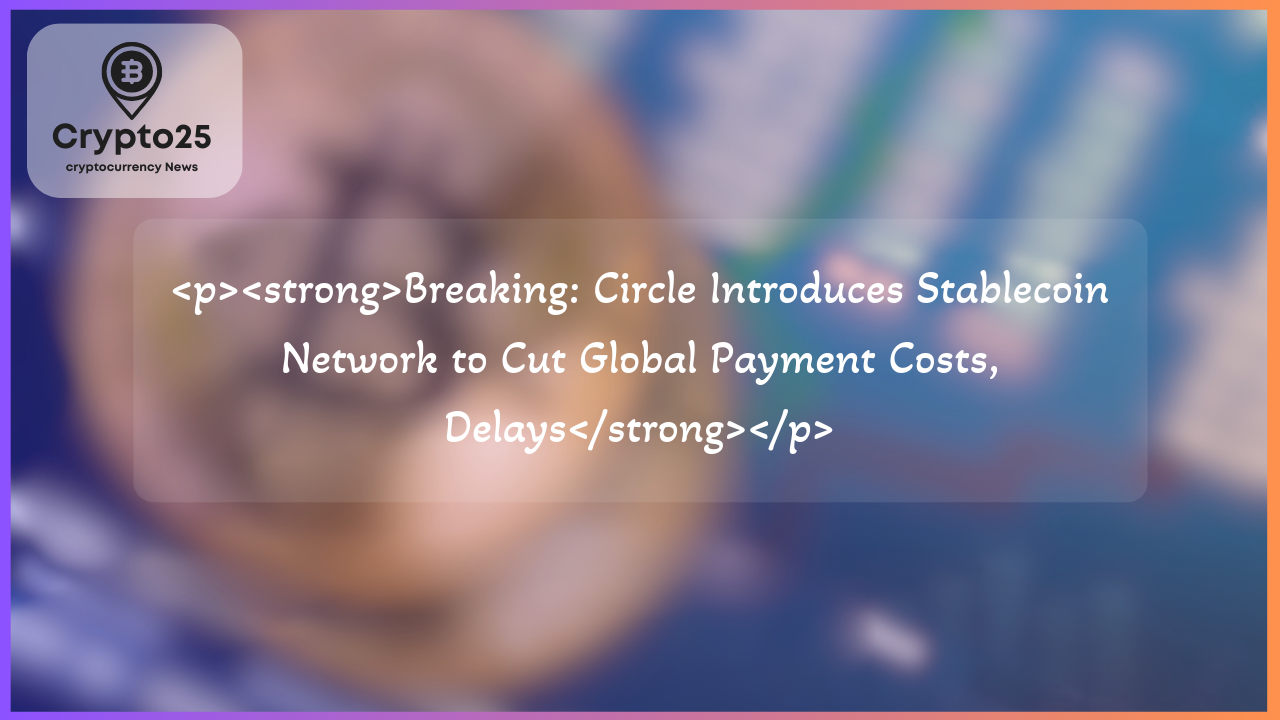
Breaking: Circle Introduces Stablecoin Network to Cut Global Payment Costs, Delays
Circle has made a groundbreaking move in the digital financial ecosystem with the launch of its new payments platform, the Circle Payments Network (CPN). Aiming to revolutionize cross-border transactions, this centralized infrastructure leverages the USDC and EURC stablecoins to provide seamless, 24/7 real-time global money transfers. Positioned as a secure, efficient, and cost-effective alternative to existing financial systems, the initiative highlights Circle’s commitment to reshaping how money moves worldwide.
## Circle Payments Network: Transforming Global Money Transfers with USDC and EURC
The Circle Payments Network (CPN) is specifically designed to modernize international payment systems by utilizing stablecoins like USDC and EURC. Unlike outdated banking protocols, which often involve delays and high fees, this platform offers instantaneous programmable transactions around the clock, redefining standards for financial institutions and enterprises alike. With use cases spanning invoice payments, remittances, payroll, and treasury management, Circle positions itself as a solution for industries that require quick, reliable, and secure settlements.
More than 20 prominent design partners, including dLocal, WorldRemit, Yellow Card, and Coins.ph, have already joined the platform, cementing its appeal across diverse financial ecosystems. Additionally, these partnerships underscore the increasing demand for innovative payment systems in emerging markets, where traditional banking systems often lag in operational efficiency. For institutions charged with managing high-volume remittance corridors, CPN could offer transformative value and simplified operations.
By integrating stablecoins like USDC and EURC into this framework, Circle ensures that transactions are backed by fully reserved digital fiat currencies. This approach not only boosts trust but also expands the use cases of its stablecoins, which have already become pivotal players in the $1.2 trillion digital asset market.
## The Need for a Revolution in Cross-Border Payments
The global financial infrastructure, reliant on antiquated settlement systems like SWIFT, has long been criticized for its inefficiency, opacity, and high costs. Cross-border transactions often take days to settle, involve multiple intermediaries, and incur substantial fees, making them cumbersome for businesses and individuals alike. Circle’s initiative directly addresses these pain points, promising “internet-speed” payments through secure and programmable transfers that operate 24/7.
While numerous fintech ventures have attempted to disrupt the cross-border payments sector, few have managed to achieve meaningful traction due to regulatory hurdles and technological limitations. Circle, however, blends the stability of well-adopted stablecoins with a resilient financial infrastructure, offering a comprehensive solution for global settlements. Moreover, the company’s ability to collaborate with “leading banks,” such as Deutsche Bank and Standard Chartered, adds credibility to its mission of bridging the gap between traditional finance and blockchain innovation.
| Title | Details |
|---|---|
| Market Cap | $1.2 Trillion |
| Combined Stablecoin Valuation | $231 Billion |
| USDC Market Share | $60 Billion |
Circle’s stablecoins are already major contributors to the growing ecosystem, with USD-based tokens such as USDC commanding a market cap of $60 billion, second only to Tether’s USDT. Within the broader digital economy, stablecoins perform as reliable mediums of exchange for traders, businesses, and institutions navigating volatile crypto markets.
## Circle Expands Its Role in the Global Financial Ecosystem
With the launch of the Circle Payments Network, the company is transitioning from its foundational role as a stablecoin issuer to becoming a vital infrastructural player in global finance. This strategy signals Circle’s ambitious goal to position itself as a critical layer within the worldwide payment system by enabling high-speed transactions for banking institutions and fintech enterprises.
Additionally, alongside its efforts to modernize monetary transfers, Circle has expressed interest in working closely with U.S. regulators to achieve clearer compliance frameworks, paving the way for broader stablecoin adoption. Reports also indicate that Circle intends to apply for a U.S. banking charter, a move that could solidify its position as a central figure in integrating blockchain technology with traditional finance.
As the needs of businesses and banks continue to evolve, Circle’s CPN could fundamentally reshape how institutions manage and settle transactions at scale. By bridging modern blockchain infrastructure with real-world financial applications, the company underscores its commitment to enhancing accessibility, security, and efficiency in payments technology.
The evolution from a cryptocurrency-powered initiative to a mainstream financial product could mark a pivotal shift in the global payment landscape. Circle’s investments in programmable settlement systems, fortified partnerships, and robust technology solutions ensure its relevance in a rapidly digitalizing economy.
As stablecoins continue to gain traction in global trade and finance, Circle’s vision of creating an “always-on” payment network—spanning continents and currencies—could bring institutional adoption of blockchain technology to unprecedented levels.
